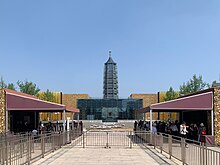
Back Porseleintoring van Nanjing Afrikaans برج الخزف فى نانجينج ARZ Torre de porzolana AST Porcelánová pagoda Czech Porzellanpagode German ނަންޖިންގެ ޕޯރސިލޭން ޓަވަރު DV Porcelanturo Esperanto Torre de porcelana Spanish Nanjingin posliinitorni Finnish Pagode de porcelaine de Nankin French
| Porcelain Tower of Nanjing | |||||||||||||
|---|---|---|---|---|---|---|---|---|---|---|---|---|---|
 Reconstructed Porcelain Tower, the original ruins depicted in the front | |||||||||||||
| Chinese | 琉璃塔 | ||||||||||||
| Literal meaning | "Veruliyam-Glazed Pagoda" | ||||||||||||
| |||||||||||||
| Great Bao'en Temple | |||||||||||||
| Traditional Chinese | 大報恩寺 | ||||||||||||
| Simplified Chinese | 大报恩寺 | ||||||||||||
| Literal meaning | "Great Temple of Repaying Kindness" | ||||||||||||
| |||||||||||||
The Porcelain Tower of Nanjing, part of the former Great Bao'en Temple, is a historical site located on the south bank of external Qinhuai River in Nanjing, China. It was a pagoda constructed in the 15th century during the Ming dynasty, but was mostly destroyed in the 19th century during the course of the Taiping Rebellion. A modern, full-size replica of it now exists in Nanjing.[1]
In 2010, Wang Jianlin, a Chinese businessman donated a billion yuan (US$156 million) to the city of Nanjing for its reconstruction. This is reported to be the largest single personal donation ever made in China.[2] In December 2015, the modern replica and surrounding park were opened to the public.[3][4]
- ^ "Nanjing pagoda - Seven wonders of the medieval world". unmuseum.org. U.N.Museum. Retrieved 28 April 2017.
- ^ "Wanda chairman makes largest donation in China's history". People's Daily. 10 November 2010. Retrieved 10 September 2011.
- ^ Yu, Elaine (2016-09-16). "Nanjing's Porcelain Tower: Ancient 'world wonder' brought back to life". CNN. Retrieved 2017-02-28.
- ^ "Thousand-year Porcelain Tower of Nanjing completes renovation". People's Daily. 2015-12-15. Retrieved 2017-02-28.